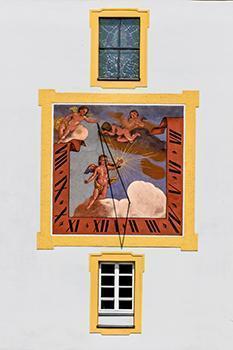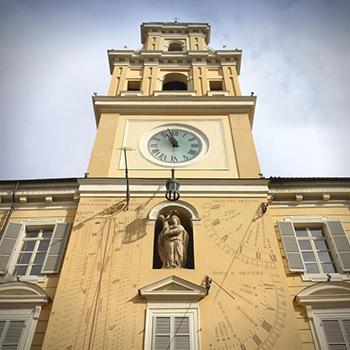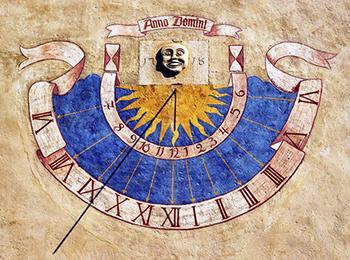Ancient sundials
Post from EditorialsOn the facades of churches, houses and palaces often note ancient sundials, or sundials, often embellished with mottoes and representation of the zodiac.
Sundials, sun clocks and quadrants
 Walking through the old towns or the countryside, you can come across ancient sundials (often very beautiful) engraved or painted on the facades of churches, houses and palaces: in fact, when mechanical clocks were still very expensive, one of the few safe ways to calculate approximately the time of day was to rely in the shadow of an object projected by the sun.
Walking through the old towns or the countryside, you can come across ancient sundials (often very beautiful) engraved or painted on the facades of churches, houses and palaces: in fact, when mechanical clocks were still very expensive, one of the few safe ways to calculate approximately the time of day was to rely in the shadow of an object projected by the sun.
However, from the technical point of view it is necessary to distinguish between sundial, sun clock and quadrant.
In fact, in terms of technical and scientific sundial it indicates only midday, so it is a specific part of the sundial or another type of indicator, useful for example to indicate the time of year: We find one on the floor of the Church of San Petronio in Bologna.
Generally it appears as a vertical dial very elongated or as a line in the shape of 8, in order to accurately indicate the hour of noon following the seasonal variations of the position of the sun.
The sundial - what we call commonly sundial and we can see on the facades of many buildings - is instead called sciatere or, more commonly, sundial: if placed vertically (as in our case) is formed by a horizontal rod, gnomon, with the basic function of projecting the shadow that shows the time, and by a quadrant of various shapes and drawing showing the hours of the day (all or only some of the wall according to the exposure and the presence of obstacles which shield the shadow).
In general sundials are accurate and reliable, but obviously have some insurmountable limitations:
- Do not take into account daylight saving time in the summer months you must add an hour to the one shown;
- They do not work at night and when the sky is overcast;
- There are not displaceable, as calibrated to a specific position;
- They may become partially or completely useless if the shadow is shielded by a permanent obstacle, like a tall tree or a new building.
Ancient sundials on the facades
 From the technical point of view and aesthetic, sundials are highly variable.
From the technical point of view and aesthetic, sundials are highly variable.
In fact, first the gnomon can be of different shapes: in the simplest cases it is a simple metal rod horizontal or inclined, placed perpendicularly relative to the wall, while in the specimens more elaborate the tip can be decorated or shaped in form of arrow.
Also the material may change, because the dial is usually painted, painted or Sgraffito on the wall, engraved directly on the masonry (whether of stone), or eventually made on a slab of stone, ceramic or clay firmly fixed to the support.
From the aesthetic point of view, the most striking part of any sundial is obviously the dial, which takes on different shapes depending on the style at the time of creation and the skill of the performer.
Sundials in poorer, often built by the users, we find only a series of lines arranged radially (the signs of several hours), almost always accompanied by a number in Arabic or Roman numerals.
In most cases, however, the dial is adorned with phrases and slogans inspired by the passing of time, the date of implementation, by the representation of the zodiac signs (in the form of small images or to the corresponding astrological symbols) and finally by small allegorical representations of the sun and the moon.  Other sundials flaunt finally real figurative scenes, mostly mold mythological or allegorical.
Other sundials flaunt finally real figurative scenes, mostly mold mythological or allegorical.
The dial most widespread is semicircular, square or rectangular, with the lines or marks indicating the hours arranged along the edges. In other cases, the dial takes the form of a melt, because the two external lines indicate the margins drawn by the shadow of the gnomon respectively on the day of the summer solstice (the nearest) and winter (the most distant).
Particularly curious is finally the facade of a building in Piazza Garibaldi in Parma, which boasts three sundials extremely refined, of which two quadrants (one for the hours of the morning and one in the afternoon) and a sundial itself.
Build a sundial
Building a solar clock is simpler than it may seem apparently. Therefore, those who want a first must choose a sunny wall for many hours a day and throughout the year, since a sundial on a wall facing south works especially in the middle of the day, while an exposed east or west will help respectively in the morning or evening.
Therefore, those who want a first must choose a sunny wall for many hours a day and throughout the year, since a sundial on a wall facing south works especially in the middle of the day, while an exposed east or west will help respectively in the morning or evening.
Next, it must prepare the gnomon, made up of variously decorated metal rod to be fixed firmly to the wall so that it is perpendicular to the sheet.
At this point, you can go to the realization of the sundial, as follows:
- Firstly, using a very accurate clock, and taking into account both the solar time (that is, during the summer and remember to take an hour), and the deviation between the now conventional (ie for example 14: 00 marked by the clock) and true solar time (in practice, the delay of the sun on the time indicated by a mechanical clock); every hour - solar - the day you must give details of the marked from the end of the shadow of the gnomon. To calculate the time in which to proceed, you can use the special tables that allow you to calculate the equation of time, that is - simplifying - the delay of the sun.
- Once you obtained the corresponding points in each hour (or every half hour if you want a sundial far more accurate), simply draw straight lines that serve as timestamps, and joining each point previously marked with the base of the gnomon. If the measurement was made in the summer, it is necessary to extend the segments appropriately, because in winter the shadows are longer: in fact it is worth remembering that the shadows are very short at the summer solstice (20 or 21 June), and the very long winter solstice (21 or 22 December), and therefore must be taken into account adequately.
- Finally, you can set the dial final, going with the color lines previously drawn, drawing the outer edges of the dial, and then enriching it with the corresponding figures at various times of day and other decorative elements, including phrases or slogans, the zodiac signs or stylized representations of the sun.
80808 REGISTERED USERS










